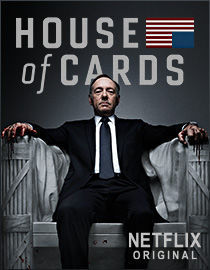
House of Cards may only be available on Netflix, but it’s worth buying a Netflix account just to watch the show. All 13 episodes of the first season were released last month, and thus House of Cards is likely to cause binge-watching and, eventually, withdrawals.
The show follows Francis Underwood (played by Kevin Spacey), a Congressman who will stop at nothing to climb his way to the top. His wife, Claire (Robin Wright), works at a nonprofit, but is just as unscrupulous and power-hungry as her husband is.
The Underwoods take politicking to the extreme, but audiences are on their side. A large part of House of Cards’ addictive quality is that we can abandon our moral compasses and sympathize with the antagonists. Francis and Claire use tactics that everybody wants to use but never would, in an effort to achieve what everyone wants: money, power, and fame. House of Cards fulfills our desires but assuages our guilt by telling us it’s okay to root for the Underwoods.
While season one as a whole is captivating, the quality of writing is inconsistent throughout the season, and there are some subplots that move extremely slowly. The episodes build, however, to a fantastic last few shows, leaving viewers craving the second season right after the first has been released.
The acting of Kevin Spacey and Robin Wright makes even the slower episodes great, and Kate Mara excels as a journalist who, also, will stop at nothing to get to the top. Most actors would try to portray Francis Underwood as a man struggling with his decisions, or regretting his past actions, but Spacey avoids the usual by making Underwood completely unscrupulous. Never do we see him feel guilty, and as a result, viewers do not have to feel guilty for wanting him to succeed. House of Cards does not exist to analyze moral dilemmas.
House of Cards seduces viewers with highly stylized sets and costumes. One has to wonder where the Underwoods get all their money – the husband is a politician and the wife runs a nonprofit – but the grand houses, expensive clothes, and always coordinated colors make the show extremely visually appealing.
Still, the Underwoods’ characters are not as beautiful as their surrounding, and the show will completely disillusion viewers who still have faith in politicians or journalists. At the same time, the plot is unrealistic enough for us to assume that Washington, D.C., is not exactly like this. Unlike The West Wing, House of Cards does not claim to represent the truth. Although its cynicism is likely justifiable, it should not be taken as an entirely accurate representation of the Capitol.
Because all episodes were released at once, many viewers will be compelled to “binge watch” the entire season in just a few days. This allows viewers to become even more immersed in House of Cards’ world and connect more with the characters, especially Francis Underwood. However, because there are only 13 episodes, the experience is over quickly and will leave viewers frantically awaiting the second season.
Each show runs for about 45 to 50 minutes, and there are 13 episodes in the first season. The show was produced originally by Netflix, and is not available for viewing anywhere else. Netflix has not yet announced a release date for season two.






